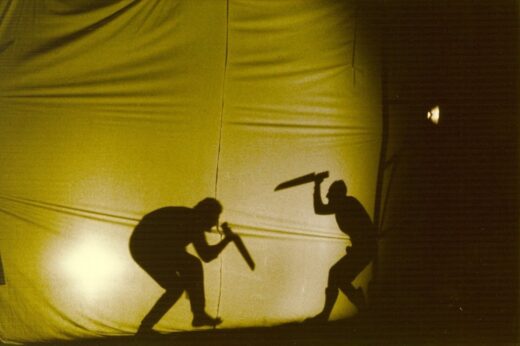
Printed
129 pages
Fantastica visione
sopra il taglio e la vendita di carne con cenni alla questione degli attori, dell'arte, del teatro e del mercato generale degli oggetti nel disarmonico presente
Guiliano Scabia’s text was written for both actors and puppets. It reinterprets a folk tale which many puppeteers from the North of Italy rewrote in the 20th century. In the tale, a butcher slaughters humans and sells them as meat in his shop (the killer’s name changes depending on the region—Biagio Carnico in Venetia, Giorgio Orsolano or the “hyena of San Giorgio” in Piedmont). The impressive work of neosemy in the play entails a fierce criticism of post-war consumerism—because all the villagers want fresh meat daily and in abundance, the butcher is “compelled” to kill his own clients to keep meeting their demands. As Gianni Celati puts it in an essay published alongside Scabia’s text: “the mystery resides in the infinite reciprocity between our flesh and its butcher. It resides in the ungovernable link between our desire and the product of our desire; in the fact that our desire binds us to what it consumes and produces, until death do them apart” (G. Celati, “La nostra carne e il suo macellaio”, in G. Scabia, Fantastica visione, 1988).
The play is built on a rich and complex metatheatrical mechanism, in which the author’s voice is heard between the scenes. The play follows on from a previous text, Commedia armoniosa del Cielo e dell’inferno (Einaudi, 1972) and was written as part of the Teatro Vagante cycle. It is split into two parts – the first being made up of 10 scenes, and the second of 14 – with a few annexes. A farce is played between the two parts – “Intermezzo del Teatro Vagante ovvero Farsa della Morte e dell’Imperatore”, which was inspired by the famous puppet scene in Cervantes’ Don Quixote.
A butcher’s clients become his victims
The play opens with a “Prologo in cielo” (prologue in the sky) during which the Teatro Vagante (an itinerant theatre) is brought down from the fly towers to the stage: the Teatro Vagante is at once a cave, a house, a cradle, a cart and a theatre. The actors have seen the theatre of the gods, which they have to try recreating now because “a mystery must be revealed”.
The mystery is about a country where people are insatiable and keep wanting to eat fresh meat, even though resources are scarce. There are no cattle, an epidemic has broken out in the countryside and rubbish produced by their residents is piling up in the suburbs. This jungle of metal is thought to be the home of spirits called “rottamat”, which people believe to be responsible for the disappearance of several villagers. Everyone praises the butcher for his excellent meat, but he turns out to be an evil character who commits murders to supply meat for his shop. Just like the devil, he takes on numerous shapes: he is simultaneously the Butcher, the Father, the crazy man Matteo and the Emperor. Every morning, the Mother and the Father (the Butcher himself) wait for the butcher’s shop to open so they can buy the best meat, even when their son is in a hospital after having been attacked by the Father. The Mother flirts with the Butcher – who embodies her erotic ideal – until she becomes his victim. Nobody suspects the Butcher. Or maybe everybody keeps quiet so they can keep enjoying his excellent meat? The killings go on until all the villagers have eaten one another. Ultimately, only the Watchman understands that the Butcher is behind the murders, but even he is killed in the end. According to the actors of the Teatro Vagante, only hope remains: “even hell can be transformed – I hope”, one of the actors declares.
First performance
Compagnia del Teatro Stabile di Brescia, stage direction by Massimo Castri.
Publications and translations
Giuliano Scabia, Fantastica visione. Milano: Feltrinelli, 1988.
Keywords
Theatrical techniques
- Prologue
- Song
- Metatheatre
- Political allegory
- Double characters
- Hidden corpse
- Dialect
- Blow-with-a-stick
- Fight
- Flying character
- Masked characters
- Dead talking character
- Apparition of the Devil
- Apparition of an angel
- Puppet theatre within the theatre
- Chase
- Tragic irony
- Stabbing
- Murder on stage
- Scene of recognition
- Splitting of the body
- Revelation
- Scene in the dark
- Seduction scene
- Dream
- Thunderbolt
- Interlude